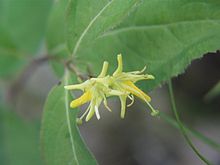Diervilla lonicera
| Diervilla lonicera | |
|---|---|
 |
|
| Scientific classification | |
| Kingdom: | Plantae |
| (unranked): | Angiosperms |
| (unranked): | Eudicots |
| (unranked): | Asterids |
| Order: | Dipsacales |
| Family: | Caprifoliaceae |
| Genus: | Diervilla |
| Species: | D. lonicera |
| Binomial name | |
|
Diervilla lonicera Mill. |
|
Diervilla lonicera, commonly referred to as northern bush honeysuckle (low bush honeysuckle, dwarf bush honeysuckle, yellow-flowered upright honeysuckle) is a native deciduous shrub found in the northeastern United States and Canada. Its specific epithet, lonicera (the Latin term for ‘honeysuckle’) refers to its similarity in appearance to the true honeysuckles, genus Lonicera.
Northern bush honeysuckle is a deciduous shrub, reaching a maximum height between 0.6 and 1.2 metres. This particular species is known for the following characteristics: branches lying close to the ground, fibrous roots, pale yellow flowers, and dry, woody fruit. Northern bush honeysuckle's simple leaves are placed in an opposite arrangement. As the seasons change, so do the leaves' colours: initially green, the leaf gradually deepens to a dark red. The flowers are in full bloom between early July and early August; the woody seeds are fully matured by September in preparation for dispersal.
Diervilla lonicera has protogynous flowers (initially female-dominant plant), is well-adapted for pollination, and its stigmas remain receptive after anthesis (fully functioning flower).
Exposed rocky sites, combined with the plant's tolerance for cool climates, dry, or infertile soils are varying characteristics to describe a typical habitat for Diervilla lonicera. It is commonly found in forests dominated by balsam fir (Abies balsamea) and jack pine (Pinus banksiana). Unlike some plant species that are restricted to specific light conditions, the northern bush honeysuckle is insensitive to changes in light, allowing for broader ranges of habitat. In addition, it is well-adapted to fire-prone habitats, because it can regenerate quickly from underground stems if destroyed by fire. For example, D.J. Schoen found that Diervilla lonicera was the most abundant shrub over a 50-year span on dry ground areas that were destroyed by fire.
Northern bush honeysuckle is found widely spread across most of North America. It grows all along the east coast of the continent, from Northern Quebec and Labrador to Georgia and Alabama and reaches as far west as Saskatchewan. Bush honeysuckle was also introduced to parts of Europe sometime in the eighteenth century, but the exact year is unknown.
...
Wikipedia
